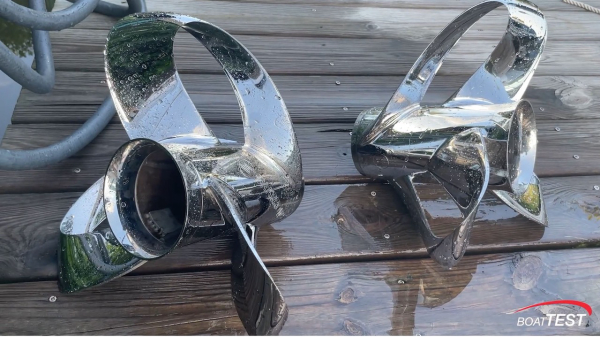Yamaha Marine has formed a partnership with a small Michigan company, Sharrow Marine, that does one thing only—it makes boat propellers. But those propellers are something special, which is why Yamaha, which already has its own propeller operation, teamed up with the company.
The deal will involve Sharrow’s propellers being manufactured at Yamaha Marine Precision Propellers facility in Greenfield, Ind. Yamaha will offer the Sharrow’s propellers as an option to more than 100 boatbuilders and its network of 2,000 dealers.
How does a tiny engineering company make a jump into the big leagues like this overnight?
Ingenuity, primarily, based on the results of independent testing on the Sharrow props.

Greg Sharrow, owner and CEO, came up with what he calls a continuous blade prop design, which looks sort of like a twisted ribbon made of stainless steel. There are no separate blades as in the typical outboard and sterndrive propellers we have all been familiar with for decades.
The design is said to form less drag and cavitation than bladed propellers, and this results in better performance.

On multiple tests, the props have shown better acceleration or hole shot, better ability to stay on plane at lower speed, better fuel economy at cruising speeds—typically around 4000 to 4500 rpm for most outboards—and slightly better top speed in many but not all cases.
Both Sharrow and BoatTEST.com have done multiple tests, running boats with standard props and then switching to Sharrow props and measuring speed with GPS or radar and the fuel flow with the onboard electronics or with a fuel flow meter. The props work, astoundingly.
For example, in a test on a World Cat 320 DC catamaran with twin Yamaha 300-hp outboards with 15.5 x 15.4 SS Sharrow props versus standard SS Yamaha SWS II 15.5 x 15 props, the Sharrow propellers.
The test showed a 36 percent fuel economy advantage for the Sharrow props at 3000 rpm and 21.6 mph.
The Sharrow’s also produced better acceleration. They put the boat on plane over 2 seconds faster. They maintained their advantage through 30 mph (1.8 seconds faster) and 40 mph (2.6 seconds faster).
Top speed was only slightly in favor of the Sharrow’s. With the Yamaha propellers, they hit a top speed of 41.6 mph at 5900 rpm where the engines used 52.4 gph. With the Sharrows, they hit 42 mph at 5500 rpm and burned 53.9 gph.
Tests on a number of other boats ranging from 52 footers down to 21 footers have shown similar results for the BoatTEST crew.
Clearly, for those running multiple large motors on powerboats, the fuel savings could be very significant, especially for anglers running far offshore on a regular basis or trolling at speed for hours on end.
The improved fuel economy also means a boat can travel farther on a given amount of fuel—the range is extended, important for those who may run a hundred miles one way in an attempt to win a tournament.
Now for the bad news.
These props sell for $5,000!
That’s five thousand, not the $500 most of us are used to paying for a good stainless steel propeller to fit a 250- to 300-hp outboard.
For large yachts, the price tag will be significantly higher—Sharrow custom machines props up to 60 inches in diameter.
Clearly, the folks at Yamaha Marine think the impressive fuel savings and the other performance advantages of the Sharrow will be enough to convince many boaters that the investment in the propellers will be worth it over several years of operation. The fuel savings will literally pay for the props over the thousands of hours of operation by many charterboat skippers as well as hard core offshore tournament anglers.
And of course amortized into the cost of a new twin or triple-engine offshore boat, the cost of the Sharrow’s won’t be a significant factor in these days when many boats are carrying $20,000 to $30,000 in electronics on the console.
If you’re among the fortunate few who can consider boats that would benefit from this technology, you can learn more at www.sharrowmarine.com.
-- Frank Sargeant
Frankmako1@gmail.com